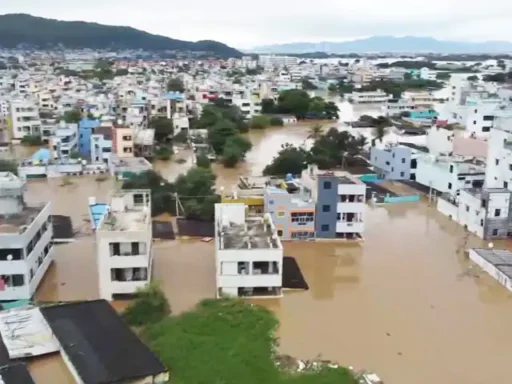
A Monsoon Disaster Hits Andhra Pradesh
In late August 2024, the city of Vijayawada in Andhra Pradesh was struck by an unprecedented deluge. In less than 24 hours on August 31, the city received over 29 cm of rainfall, overwhelming local rivers and drainage systems. The Krishna River and the Budameru rivulet burst their banks, inundating large swathes of the city.
-
At least 35 people lost their lives in the floodwaters.
-
Around 270,000 residents were directly affected, and 650,000 across the district experienced displacement.
-
Property, infrastructure and agricultural land suffered extensive damage, with costs estimated in the hundreds of crores.
This flooding exposed glaring gaps in urban planning, stormwater management, and disaster response in a rapidly growing city.
How It Unfolded
-
Torrential convective storms hovered over Vijayawada from the night of August 31.
-
The Budameru rivulet, usually manageable, became a high-flow waterway within hours, flooding adjacent neighbourhoods.
-
Low-lying zones were hit first—waters rose quickly, trapping families in homes, shops, and vehicles.
-
The emergency response was overwhelmed; roads became rivers, rescue boats shuttled stranded residents, and major hospitals were flooded.
City authorities scrambled to open relief camps, deploy NDRF and local rescue teams, and restore essential services.
What Went Wrong Behind the Scenes
-
Drainage Infrastructure Failure
Many stormwater drains were either undersized or clogged. Drain projects begun over a decade ago remained partially unfinished. Encroachments along natural waterways worsened flows. -
Unplanned Expansion
Rapid urban growth had filled ecologically sensitive recharge zones. Floodplains had been built over, intensifying waterlogging during heavy rains. -
Lack of Early Warning Systems
The rainfall intensity was high, but real-time alerts to citizens and communities were limited or delayed, hindering pre-emptive evacuation. -
Delayed Civic Response
Waterlogging alerts were posted late, clearing of clogged drains was slow, and evacuation centres lacked timely setup.
Human Cost and Economic Impact
-
Hundreds of thousands faced displacement and loss of shelter.
-
Landslides, crop losses, and animal deaths were reported in rural outskirts.
-
Cash holds, schools, and shops were submerged.
-
Healthcare facilities and relief shelters suffered critical disruptions—threatening public health and sanitation.
Efforts to Respond and Recover
-
The Vijayawada Municipal Corporation, state administration, and the Andhra Pradesh Capital Region Development Authority (APCRDA) mobilized to restore drainage works and provide relief housing. As an example, earlier stalled projects on the Budameru canal were resumed immediately.
-
Over 10,000 residents sheltered in temporary camps; military and state forest services assisted rescue efforts.
-
Power and water services were restored gradually; clean‑up operations and debris clearance extended into September.
Lessons from the Flood
-
Infrastructure resilience is critical: cities must ensure stormwater systems function under extreme weather.
-
Water-sensitive development must protect recharge zones and natural floodplains—not build on them.
-
Community awareness and early warning systems must be institutionalized.
-
Coordination across agencies is essential to swiftly evacuate, rescue, and manage victims during disasters.
-
Urban planning should integrate climate projections—densely populated cities must have buffer zones and green infrastructure for flood absorption.